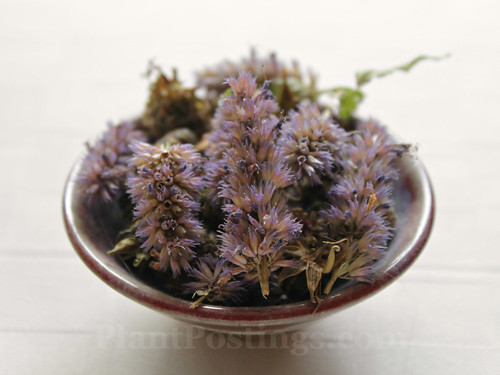
As we move through the depths of winter, many of us treasure tangible reminders of the garden's plenty. Dried seed heads and flowers, including the Anise Hyssop (Agastache foeniculum) in my potpourri bowl, fulfill this purpose.

Outdoors, the plants (and the picnic table) are coated with a few inches of fluffy, white snow--just enough to keep the landscape fresh and sparkly. We awoke this morning to a new dance of gently falling snowflakes ...
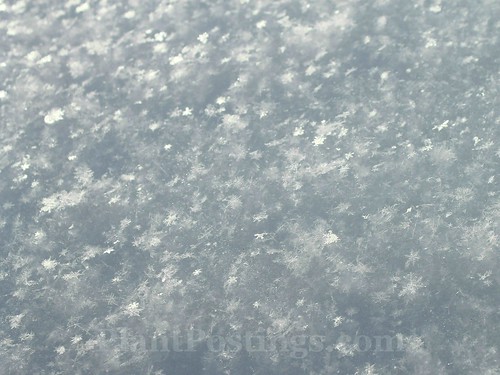
Those huge, puffy flakes that are so large you can easily see how each one is different from the next, and the air between them creates depths of beneficial insulation. (Did you know that fresh, uncompacted snow typically is 90% to 95% trapped air?)
As I contemplate the perennials under their winter blanket and smell the licorice/mint scent of my potpourri, I remember how beautiful, fragrant, and soft the Anise Hyssop was during the growing season.
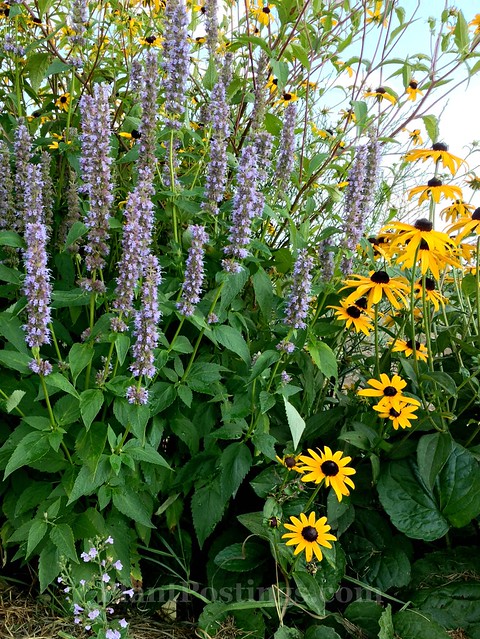
It was a perfect partner to the Rudbeckias, Echinaceas, and Calaminthas in the pollinator garden I helped establish as a master naturalist volunteer project.
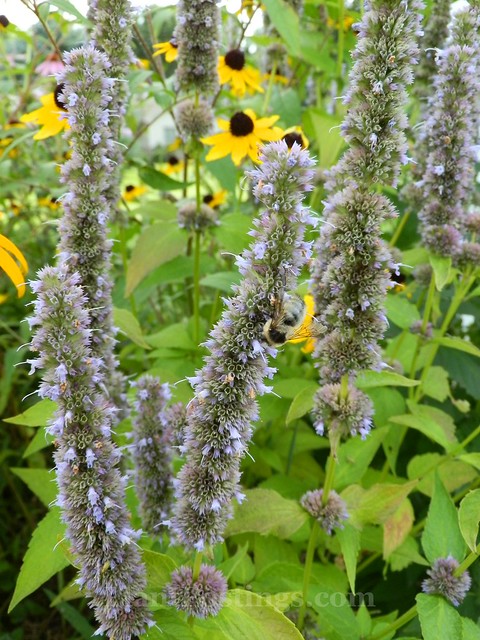
Each flower stalk was fluffy and soft as a cat's tail.
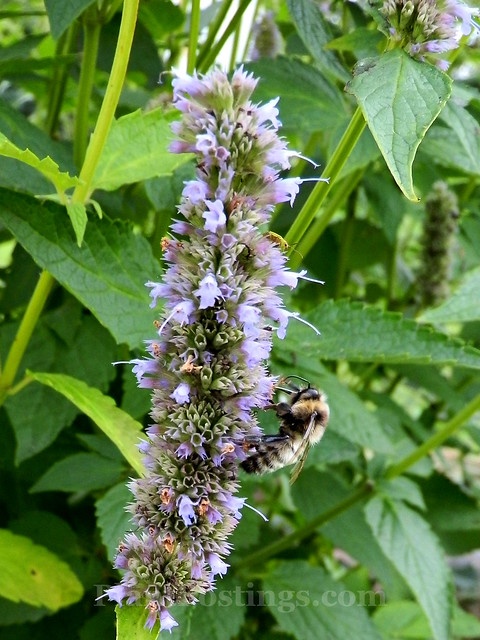
Pollinators like this bumble bee ...
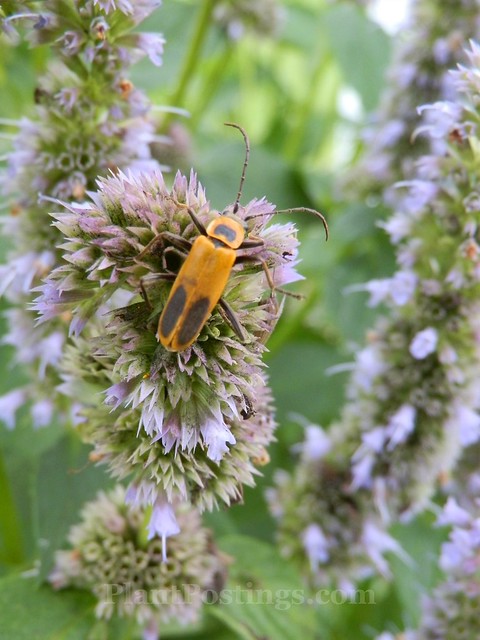
And this Goldenrod Soldier Beetle found it irresistible.

I liked the way it wrapped around and hugged the fence posts. Very romantic.
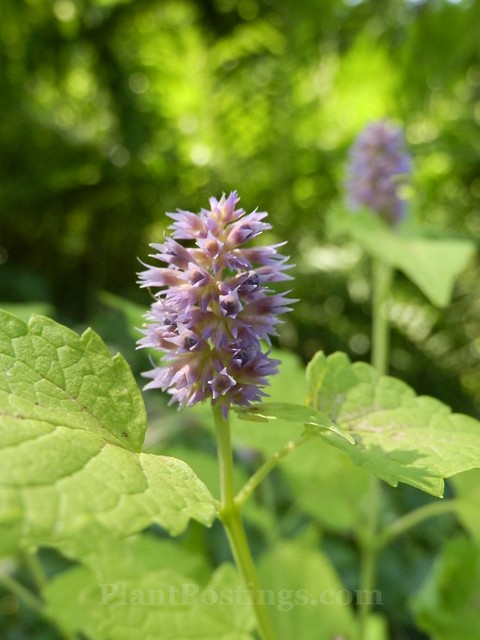
While the straight-species seeds I winter sowed last year didn't germinate in my garden, I did have luck with small seedling plants of A. foeniculum 'Golden Jubilee.' I'll try the straight species again this spring, but in the meantime, I sure enjoyed the pretty flower spikes and the bright, chartreuse color of the cultivar's foliage.

As the days progressed, the flowers gained character. I snipped them to encourage new blooms and, although that didn't pay off with my young plants, I'm happy I saved the flowers for my potpourri. The scent became even more concentrated as they dried.

At the end of the season, when very few plants were still flowering, the Anise Hyssop was still blooming away--a great companion to late-season Goldenrod (Solidago rugosa), and other fall bloomers.
I didn't realize until recently that both the flowers and the foliage of Anise Hyssop are edible. Other fast facts, based on information from the Missouri Botanical Garden, the USDA, and the Lady Bird Johnson Wildflower Center:
- Native to a large portion of the northern U.S., the Appalacians, and Canada;
- Height: 2 ft. to 4 ft. (a little shorter for some of the cultivars), with a similar spread;
- Hardy: zones 4 to 8 (a little warmer for some of the cultivars);
- Bloom time: late June to hard frost (in my experience here in Southern Wisconsin);
- Light requirements: Full sun to part shade (bigger flower spikes in full sun; foliage of 'Golden Jubilee' remains more vibrant in partial shade);
- Attracts butterflies, beetles, bees, and hummingbirds, and is of special value to native bees and honey bees, according to the Xerces Society;
- Flower spikes provide form, texture, and color to fresh and dried floral arrangements;
- Tolerates drought, but prefers average to moist, well-drained soil.
All I know is that I like it, I don't know why I didn't have it in my garden until recently, and I'm looking forward to seeing it bloom again!

It's very pretty. I don't have it and I should.
ReplyDeleteYes, I fell in love with it this past summer. It's one of those plants that pleases all the senses--sight, taste, scent, touch, and even sound, when the large stalks and flowers are blowing in the wind.
DeleteThis is one of my favorite natives that is seeding itself all over my front garden, but I don't mind as it is a perfect flower. I should bring some in next year and dry it.
ReplyDeleteI have heard that it re-seeds easily. I was surprised that none of my winter-sown seeds germinated. But of course, my garden is shady, so seed germination is a little tricky. It will be interesting to see if the plants magically appear this year from the old seeds.
DeleteExcellent post. Nice coverage for all seasons. Agastache has not been very successful in my garden. I'm going to try again after reading this; it has so many outstanding features I like.
ReplyDeleteThanks, Jane. Yes, I agree re: outstanding features. In particular, it's so beneficial to the pollinators!
DeleteI haven't had the best of luck with Agastache, but I think you've just convinced me to try again.
ReplyDeleteIn my own garden, I had better luck starting with small plants than with seed. So, that's the method I'll try again this spring. In the sunny pollinator garden near a farm, it's a very happy plant!
DeleteYour post convinces me that I should try again. I use to have it but I think I neglected it and it did not do all that well. It looks beautiful in your photos.
ReplyDeleteThank you, Alain. Yes, I will try again in my shady garden, too, with the straight species. It's such a beautiful plant, and it blooms for several months!
DeleteI have Hyssop and Goldenrod in my garden too. The pollinators enjoyed them, but both played second fiddle to two non-natives in my garden, Caryopteris and Perovskia. The pollinators swarmed those two plants this year.
ReplyDeleteThat's interesting, Donna. I enjoyed a trip to some university test gardens last summer, where the pollinator preferences are obvious when plants are placed side-by-side. The nice thing about the Hyssop and Goldenrod in the sunny pollinator garden was that both were still blooming until mid-October. And they were both covered with bees!
DeleteAbsolutely one of my favorites. Great for pollinators, very adaptable, and I love the blue flower spikes. And the fragrance! I could probably mail you some of my volunteer seedlings of the straight species if you have any interest.
ReplyDeleteYes, I remember you and others recommending the Agastache, Jason. I didn't think it would grow in shade, but I guess dappled sunlight will suffice (for smaller plants, anyway). Thanks for the offer of the volunteer seedlings! I'm thinking I might find some stragglers I can bring home from the pollinator garden. But if not, I might take you up on the offer. Cheers!
DeleteI have found that they don't really need full sun. The other thing is that they can be fairly short lived (the straight A. foeniculum, anyway), but of course they always produce lots of volunteers.
DeleteI love this plant and nice to remember back to before all this snow... Michelle
ReplyDeleteWe have just enough snow here. I'm glad it's not too heavy, but enough to keep the plants protected. Stay warm and safe!
DeleteI've finally just cut all mine back--it has been so hearty! Wonderful to see it in full bloom as a reminder of what summer will be like. Wonderful species for filling a large garden space too. The pollinators love it!
ReplyDeleteYes, I can see how it would be a great plant for an area that you just want to fill in with ornamental, pollinator-friendly plants. I was surprised at how soft the flower spikes are, too.
DeleteThis is a staple in my garden especially for bees. I love that you dried the flowers. I'll have to remember to do that this year! Interesting that the straight species didn't germinate. I wonder why. I hope you have better luck this year.
ReplyDeleteI didn't have much luck with winter sowing last year--maybe because we had such a very cold winter, or because my garden is so shady the seeds didn't get enough sun. In any case, I imagine small plants of the straight species will perform better, so that's my hope. The flower spikes from the pollinator garden were huge. But the ones in my shady garden were smaller--perfect for potpourri. :)
DeleteWhat a lovely flower, would love this in my garden and how wonderful your photos look, i's snowed a little here to day, nice and bright but the cold wind goes right through you..so it was nice to see you summery photos.
ReplyDeleteAmanda xx
Ah yes: that cold wind that goes right through you! I know it well! We are about to experience a "January thaw" after some very cold days at the beginning of the month. Above freezing temps will feel tropical after that string of subzero (<0F/-17C) weather. Enjoy the snow, but stay warm!
DeleteI have 'Blue Fortune' and it's the #1 pollinator attractor in my garden. I love how robust this plant is and always recommend it to any one wanting to attract bees/butterflies. :o) Come to think of it, it's one of my favorite plants. But my list of favorites is so very long!
ReplyDeleteI've heard great things about 'Blue Fortune,' too. Yep, the "favorites" list is so long here, too! If someone asked me to pick five (or even 10 or 20) favorite plants, I would have an anxiety attack. ;-)
DeleteGreat imaginations when outside plants are under the soil and covered with a layer of snow. A long time ago I have sown Agastache foeniculum and I still have some plants (I hope), because they sow themselves now. In the Netherlands we call it 'dropplant', translated licorice plant,
ReplyDelete"Dropplant" ... that's interesting! Yes, it does smell like licorice, doesn't it, but slightly more herbal and minty. I'll be curious to find out how it performs in my garden, since I clipped off all the seed heads. I'll be adding more Agastache plants in the same area, though. Thanks for those thoughts!
DeleteI know Agastache foeniculum from "the wild" ... in moist woods of the Black Hills. It's a good friend. The younger leaves are sweet and refreshing to chew (and then spit out). Whenever I meet up with the hyssop, I always pick some of the upper leaves and and happily chew on them for awhile.
ReplyDeleteYes, I've seen it along some hikes here, too. It doesn't seem quite as prevalent as some other spiky plants, though. And I didn't think it would grow in the shade. I was wrong. I'm thinking I'll try some of the leaves and sprinklings of the flowers on my salads next summer. :)
DeleteWell plants under a fluffy feather-blanket now and let you grow beautifully in the spring and summer, whatever you want. Regards.
ReplyDeleteThanks for stopping by, Giga. :) Yes, everything has its season. The snow is beautiful in its own way, and it protects the plants for the next growing season. Cheers!
DeleteIt's a beauty, that. I love plants that work in every way--attractive to people and wildlife, fragrant, useful as dried specimens--the works. I don't think the Agastache species work particularly well where I'm from, so I'll enjoy yours!
ReplyDeleteI agree: The plants that serve multiple purposes are special treasures. And each habitat, region, and geographical area has its own!
DeleteThat's really beautiful flower! Thanks for sharing!
ReplyDeleteYou're welcome, Endah! Thanks for sharing your beautiful flowers, too!
DeleteThat Anise Hyssop is beautiful. I have seedheads from my Silverbell tree; pretty but no fragrance. Just enough snow at our house to coat the landscape but I am enjoying mostly dry roads.
ReplyDeleteI'm enjoying creating my own natural potpourri more as time goes by. There's something fascinating about the connection between a plant in the garden and the seeds that I save and study (and plant the next season). And, yes, cheers about the clear roads for safer travels!
DeleteI am recent convert to agastache, and am hoping that this year will bring lots of those lovely flower spikes. Great idea to have dried flowers to remind you of the summer blooms to come when all outside is blanketed in snow.
ReplyDeleteThe dried flowers and seed heads have a special attraction for me--for various reasons. Part of it is the fascination with the promise of new life after the winter. :) Good luck with the Agastache!
DeleteGoodness, all that snow! How nice to have the pot pourri to remind you of a beautiful plant. It is one that I am going to try next year.
ReplyDeleteTee hee. Actually, this isn't a big snow for us. We frequently have several feet of snow on the ground this time of year. No complaints by me, though. I like to have just enough to protect the plants. ;-) Good luck with your new plants!
DeleteThat's the greatness of nature, in winter you can still enjoy summer flowers. Good content with the contrast of summer blooms and the white winter. How lucky to have that snow!
ReplyDeleteThank you, Lula! It's so interesting that you mentioned you look forward to snow. I guess, in a way, I do, too. Until it overstays its welcome in March. ;-)
DeleteBeautiful pics as always -- and a familiar sight, as that last photo could have been taken along a section of the nearby bike path. I think you'll appreciate today's Thursday 13 post on my blog. ;-)
ReplyDeleteThank you, Heather! Yes, I enjoyed your post! Yep, these flowers are common around here, aren't they? Lucky us!
DeleteThanks for introducing me to all these plants I don’t know anything about Beth, yet another one I had not heard of :-) Beautiful photos and I can see why you love this one.
ReplyDeleteYou're welcome, Helene. And thank you for introducing me to so many plants! I have trouble thinking of any problems with this plant, except that, apparently it can self-seed and spread a bit. In the location in my garden, that wouldn't be much of an issue. And I enjoy the pollinators it attracts. :)
DeleteWhat a beautiful memory of summer while your garden is covered in that beautiful blanket of white! I sometimes miss real winter (used to garden in zone 3) but I do love seeing things blooming too.
ReplyDeleteYes, I think I would enjoy being able to garden year-round. It's nice to have a little break in December and January, but I'm ready for green plants and flowers way before they reappear here in Wisconsin! I guess that's a good excuse to travel in February and March!
DeleteYou take such beautiful photographs. I like your bullet point list for the plant facts - it makes it really easy to take the information in.
ReplyDeleteThank you, Tim, you are so kind. I'm glad you found the bullet points helpful. They help me to organize my thoughts and the information, too. ;-)
DeleteI didn't plant Agastache in my garden for a long time, because I hate the flavors and smell of anise and licorice. However, after smelling Agastache, the scent is not quite the same, much more delicate and.. minty? I love the smell, and ended up sniffing my Agastache ever time I passed it! Great plants, and the pollinators do love them!
ReplyDeleteI'm not a huge fan of strong anise/licorice scent either, Indie. But I agree with you that the Anise Hyssop scent is pleasant. Maybe it's because it's more like a hint of anise, with a fresher, more minty fragrance? I found that the straight species was more pungeant than 'Golden Julbilee' during the growing season. But, wow, the dried GJ flowers are great for potpourri!
DeleteI love Agastache! While I prefer the more colorful cultivars, they usually don't last more than one season in my garden. But the one straight species plant I have has been going strong for several years without any special care from me. 'Golden Jubilee' is lovely for its foliage, too. I never thought to dry the flowers--thanks for the suggestion!
ReplyDeleteAh, good to know, Rose. I'll be curious to see if 'Golden Jubilee' comes back and if it will thrive for another year. Also, it will be so fun to see the second year's growth on the pollinator garden! I'm so glad I kept those flowers for potpourri after I snipped them off!
DeleteGolden Jubilee grows well here in partial shade. I tried transplanting some volunteer seedlings to a sunnier spot and they survived (although they didn't grow very large last year). I also tried some Agastache rugosa, which grew well and attracted finches to eat the seeds, but I can't speak yet as to whether that will return or self-sow...
ReplyDeleteBut yes, Agastaches in general are 5-star plants that should be (and could be) used more often in many gardens throughout the U.S. !! :)
Now I'm curious to try some other species and cultivars of Agastache. It's so interesting to have perceptions blasted. For example, my perception that I couldn't grow Agastache in the shade. I'm glad I tried it. I do hope it will come back for another season. Stay tuned!
DeleteYour photo of the crystalline snow is magical. No, I did not know that uncompacted snow trapped that much air! Your anise hyssop is wonderful; the best part about this flower is its fragrance. I have tried to grow it, but it did not like my high heat and humid summers. Too bad!
ReplyDeleteThe snow was so pretty that morning, I couldn't resist snapping a couple of photos. It's weird how the snow compacted quickly and started melting with the warmer weather. Now we have very little left! Regarding summer heat: Our 2014 summer was cool. Perhaps it was a very good year for the Agastaches? The ones in the pollinator garden are in a sunny location. It seems those two factors--sun and mild summer temperatures--yielded a bumper crop of Agastache in the pollinator garden!
DeleteWhat an extremely useful plant to grow in the garden. I can't get Agastache to like my garden, which is sad as I love it. I'll have to make do with admiring your Beth.
ReplyDeleteGreat post, full of very useful information.
Thanks, Angie. I shouldn't be so quick to recommend it, since I have only one year of first-hand experience with it. But I do think the plants in the pollinator garden have established nicely. Not entirely certain about the plant's reappearance here in my home garden. We shall see! I certainly hope so, because it's a lovely plant!
DeleteHello,
ReplyDeleteI love to garden!! How fun to have found your blog! And from Wisconsin too!! YaY!
Your photos are amazing.
Thank you for sharing your information. Looking forward to more.
Carla
Hi Carla: Yes, it's great to find your blog! Thank you for your kind comments. It will be fun to follow each others' blogs. :)
DeleteFantastic perennial Beth! I grow it too. So much to like about it as you said. I've never dried it tho. I bet it is terrifically fragrant.
ReplyDeletebtw, I love to speculate about Downton Abbey too! That show is the fastest hour on TV! Zips by way too quickly!
Hi Kathleen: I can't wait to watch the next episode of Downton Abbey. It must be so difficult for our British friends to keep quiet about the "big happenings" of the season while Americans are just catching up. I wish we could all watch it together. Regarding the Agastache, yes, definitely a winner!
DeleteLove these. I did have a swarm of them in my garden at one time, but they disappeared. Must get them again. And the chartreuse one looks fantastic.
ReplyDeleteHi Sarah: Yes, they're great plants. I hope mine come back this spring/summer. In the meantime, I'm enjoying the potpourri. :)
Delete